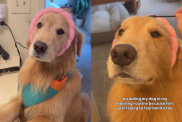Cuddle time: The sweet way to socialize your dog
Living with and loving a dog you can’t touch, cuddle, or hug is just about as silly as living with and loving a person you can’t touch, cuddle, or hug. It’s also potentially dangerous. One of these days, a strange child is likely to run up and try to hug and pet your dog, and if your dog objects, all three of you are in trouble.
Hard-to-handle dogs also make vet exams, teeth cleaning, and grooming more difficult, and sometimes more expensive. Nevertheless, it’s very common for family dogs to resist handling and examination.
Luckily, it’s quite easy–and enjoyable–to teach young puppies to enjoy being touched, even by strangers. Teaching adolescent and adult dogs the same skill can be time consuming. So it’s best to start early if you can.
Games that head off a hard-to-handle dog
Provided your pup was handled often in early puppyhood he should go as limp as a noodle when picked up and settle down as relaxed as a rag doll on your lap. But even if your puppy didn’t have the benefit of early handling in his original home, these exercises are easy.
Once you’ve had a chance to play the game with your puppy, pass him off to someone else to repeat the whole procedure.
Lap time: Put your pup on your lap, hooking one finger around his collar so he doesn’t jump off. Slowly and repetitively stroke along the top of his head and back to settle him down. If he squirms, soothingly massage his chest or the base of his ears.
Tummy rubs: Once he’s completely relaxed, lay him down on his back for a soothing tummy rub, making a repetitive circular motion with the palm of your hand. Gently rubbing the pup’s inguinal area (where the inside of the thigh meets the abdomen) will also help the puppy settle down.
Hugs: When your puppy’s calm, periodically pick him up for a short hug and maybe a kiss on the nose. Gradually and progressively increase the length of the hugs. This gets him used to being restrained.
For puppy tantrums: Keep one hand on your pup’s collar and the palm of your other hand against his chest, and gently but firmly hold him against your stomach, with his legs pointing away from you. Keep him low down on your body so he can’t turn around and bite your face.
Gently massage his ears with the fingers of one hand and his chest with the fingertips of your other hand. As soon as the puppy stops struggling, praise him, and after a few seconds of calm, let him go. Then go back to the handling games.
Games that defuse “hot spots”
Many dogs have a number of “hot spots,” which, if not defused in puppyhood, can be extremely sensitive to touch–usually the ears, paws, muzzle, collar area, and rear end.
Some of these areas (such as mouths and rear ends) become sensitive over time simply because nobody bothers to touch them there. Other areas, such as legs and paws, are naturally sensitive. And some areas turn into hot spots because of mishandling. For instance, dogs with droopy ears, which are prone to infection, may learn to associate touching their ears with pain.
Simple handling exercises can help your puppy form positive associations with these areas:
Trade treats for touch: Measure out your puppy’s daily allotment of kibble and use it as training treats. Take hold of your pup’s collar and offer a treat. Gaze into his eyes and offer a treat. Look in one ear and offer a treat. Look in the other ear and offer another treat. Hold a paw and offer a treat. Repeat with each paw. Open his mouth and offer a treat. Feel his rear end and private parts and offer two treats.
Then repeat the sequence, handling and examining each area more thoroughly and for longer periods each time.
Once your puppy is happy to be examined by family members, it’s time to invite some guests over to play Pass the Puppy. One at a time, have each guest repeat the process described above, offering a treat at each step. Then pass the pup (and the bag of dinner kibble) to the next person.
As well as teaching your pup to tolerate cuddling and exams, you’ll also need to teach him to be okay with being grabbed by the collar–one of the most common triggers for dog bites.
Warning signs: If your puppy just doesn’t like to be touched
If you have difficulty getting the pup to calm down and enjoy these exercises after one day of practice, call a trainer to your home immediately. This is an emergency. You don’t want to live with a dog you can’t handle or hug. Contact the Association of Pet Dog Trainers at 1-800-PET-DOGS or www.apdt.com to locate a Certified Pet Dog Trainer in your area.









